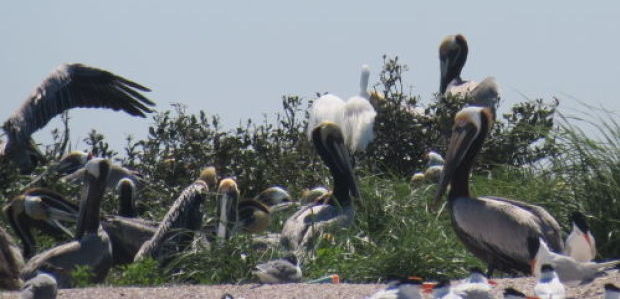
HB142 lauded for university funding
April 15, 2014
After 3 decades, Fletcher’s leader to step aside
April 15, 2014At first, the focus was on people.
A blowout at a rig nearly 50 miles off the Louisiana coast on April 20, 2010, killed 11 workers and injured 17 others.
But the focus rapidly shifted as oil from BP’s Macondo well site continued gushing into Gulf of Mexico waters, a mile beneath the surface, for five months to come.
Emotional claims’ forums and bitterness toward the Obama administration for a moratorium on deepwater drilling marked local reaction to the spill.
Now, four years later, the furor has calmed down. Some who claim health issues related to the spill cleanup, exacerbated, they say, from dispersant material used by BP, continue pressing their cases. Owners of some businesses paid for estimated losses acknowledge being made whole, while others say they got the short end of the stick.
And local government officials, while noting the losses and the threat of what could have been worse, appear satisfied for the most part that what could be done has been done, at least for now. Remediation projects are still underway, and more money is likely to be spent on local projects once certain litigation issues are resolved.
“The Deepwater Horizon oil spill was a tragedy and we must never forget those who were killed in this accident,” Terrebonne Parish President Michel Claudet said, in response to questions about his thoughts on the anniversary. “While there are still emotional, economic and environmental challenges present, our ever-resilient parish has for the most part bounced back from this accident. We will also have coastal restoration funding available that would not have been available to us had it not been for the NRDA and RESTORE Act funds that will reach Terrebonne. We now even have the potential of our Houma Navigational Canal protection being funded and constructed.”
Terrebonne, Claudet said, will continue to work “with state officials, the Coast Guard, and BP to make certain that impacts of the spill on Terrebonne continue to be recognized and addressed.”
Lafourche Parish President Charlotte Randolph has expressed similar thoughts, although at the height of the incident her ire appeared focused more on the president than BP, because of the drilling moratorium.
Shrimp buyer Dean Blanchard, who has operated his Grand Isle dock for more than 30 years, says little is better environmentally speaking and that “it is all worse.”
Like others, Blanchard drily notes that “Louisiana got all the oil and Florida got the money,” a reference to the claims process.
“There was no real cleanup,” he said. “If you were trying to clean it up, why would you use dispersants to sink the oil to the bottom?
“In Barataria Bay, there is a 50-mile circle we are saying is really messed up. They sprayed dispersant and just destroyed that place. There is nobody hardly fishing Grand Isle anymore. On the bay side, you see pirogues and there are a few shrimpers that come in. They try but they don’t stay long. …Everything has moved further to the west. It’s a mess. Everything we have been saying the scientists are saying the same thing.
“You can see from the numbers that Barataria and Terrebonne used to be neck and neck for shrimp production,” Blanchard said. “Ever since the spill Terrebonne Bay is bearing us three and four and five to one. They don’t want to admit they messed up Barataria Bay, they want everyone to think it’s all right.”
Clear evidence linking poor crab catches and issues with shrimp to the BP spill is still lacking.
Louisiana SeaGrant liaison Julie Falgout, who worked out of BP’s La. Highway 311 headquarters during the disaster, says that in retrospect, some fishing families derived benefits from the spill not otherwise possible, while some remained uncompensated and have not been “made whole.”
“The real story won’t be told until the research on the resources is completed,” she said. “Unfortunately, research takes time. We can all say things that we think but until somebody verifies it for you it’s just that – that we think as opposed to things we know. Our fishermen know things, but until science comes in and verifies that it doesn’t have the weight for argument.”
Evidence of oil damage in Barataria Bay was made clear last week, when a gaggle of cameramen, reporters and photographers piled into a fleet of seven charter boats hired by the National Wildlife Federation, to observe firsthand what the oil had left behind.
“Most of the studies are being done under the National Resource Damage Assessment,” said David Muth, the National Wildlife Federation’s Director for Mississippi River Delta Restoration before the boats set out Thursday from a marina near Belle Chasse. “Almost all of that is still secret, still being held because they haven’t gone to trial yet. Both sides – BP and the federal trustees – are keeping a lot of studies from being released. But we are beginning to see a trickle of studies that are coming out independently or where agencies feel the public benefit of releasing the studies is higher than waiting to go to trial.”
The federation released a report last week, which chronicles what appears to be known thus far about the spill’s environmental impact.
That damage has occurred is apparent; the science linking that damage to the spill is the puzzle piece, as noted by Muth, which is missing.
The federation, in its report, was comfortable stating what data has been collected on certain marine species that appear to have fared the worst.
Bottlenose Dolphins: The report says more than 900 have been found dead or stranded in the spill area since April 2010. In 2013 dolphins were found dead “at more than three times normal rates.” Some have displayed “unusual lung damage and immune system problems.”
Sea Turtles: Roughly 500 have been found dead every year for the past three years in the area affected by the spill, the report says.
Oysters: Reproduction remained low over large areas of the northern Gulf at least through the fall of 2012, according to the report.
Tuna: The report states a chemical in oil from the Deepwater Horizon spill has been shown to cause irregular heartbeats in bluefin and yellow fin tuna that can lead to heart attacks, or even death.
Loons: Those wintering on the Louisiana coast, the report says, “have increasing concentrations of toxic oil compounds in their blood.”
Sperm whales: The report says they have higher levels of DNA-damaging metals in the Gul than among populations elsewhere.
Dramatic evidence of damage from the spill was visible in Cat Bay, on a nearly-decimated island where mangroves once flourished.
The mangroves, along with other vegetation, provided nesting cover for thousands of pelicans, roseate spoonbills and other marine birds.
The island local fishermen identified as a former pelican rookery was devoid of life other than a few visible hermit crabs. Stalks of former mangroves on a darkened area of the island gave the appearance that it was the scene of a forest fire.
About a mile away pelican and spoonbill colonies were observed, though the charter fishermen say they are sparse compared with what once was.
“There was a whole suite of birds nesting on those islands at the height of the spill,” Muth said. “Those islands are now dead.”
No reports thus far issued have addressed the direct effects on pelicans. Ornithologists have said there is no telling what happened to pelicans not oiled enough to be caught and rehabbed. Those birds would have ingested oil from thin coatings on their feathers, and many may have died.
The Wildlife Federation tour included remediation work.
At Hermitage Island, within sight of the Mississippi River, bulldozers and other shoreline equipment were evidence of marsh re-building that is part of a $1 billion in early NRDA work funded by BP.
The project, an extension of work already begun by the state, will create 104 acres of marsh within the Barataria Hydrologic Basin in Plaquemines Parish.
Sediment dredged from the Mississippi is being pumped via pipeline to the project area.
“This is designed to produce the desired elevation and the ability to plant native vegetation in the sediment,” a BP statement says.
The Hermitage project’s estimated base cost is $13,200,000.
Other projects agreed to between BP and federal trustees include an oyster project creating clutch areas across 850 acres throughout coastal Louisiana, and development of an oyster hatchery on Grand Isle. The cost is estimated at $14,874,300.
Laura Folse, BP’s executive vice president for response and environmental restoration, said the Louisiana projects, along with “extensive cleanup efforts … and natural recovery processes” are returning the Gulf to its baseline condition.
That, she said, is “the condition it would be in if the accident had not occurred.”
The money comes from a $20 billion trust BP established in 2010 to pay claims, final judgments in litigation and litigation settlements, state and local response costs and claims, and natural resource damages and related costs.
BP notes that in addition to early restoration projects, it has spent $14 billion in operation response and cleanup costs; $10.7 billion to individuals, businesses and government entities for claims, settlements and other payments; that’s in addition to money that will be paid out according to an agreement with the plaintiff’s steering committee in connection with a major lawsuit, for loss, property damage and medical claims.
A major Plaintiff’s Steering Committee will resolve the substantial majority of outstanding private economic lawsuit. It has agreed to a settlement with the loss, property damage and medical claims.
Included among early restoration projects is one on Whiskey Island near Terrebonne, as well as restoration of dunes, beaches and marsh at other locations, at a cost of more than $318 million.
Carey Perry, science director for the Coalition to Restore Coastal Louisiana, went along for the Wildlife Federation ride and said she understands how many in Louisiana were angered by the shutdown of deepwater drilling after the spill. But work to restore lost land and things like pelican nesting sites are important at this stage of the game, she said, and seeing to it that Louisiana gets its share of restorative programs offers a positive look for the future.
“I understand people were angry that they had shut down new leases,” Perry said. “But what we try to tell people is that we can focus right now on restoring what has been lost, to make sure our money does come back to us.
“This oil spill added insult to injury. What we try to tell people is that what we can focus on right now is restoring on what has been lost, to make sure that money does come back to us. What good does it do to be mad at the president? That’s not going to save the oysters, save the coastline or save the community. But if we make sure the money goes to Louisiana, to the areas that were most affected by the oil spill, those are positive directions in which to steer people’s thoughts.”
Pelicans, rare roseate spoonbills and gulls on an island in Barataria Bay. Wildlife advocates say more birds occupied nearby islands but abandoned them when oil from the Deepwater Horizon spill fouled mangroves and other vegetation.














